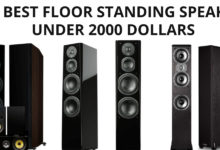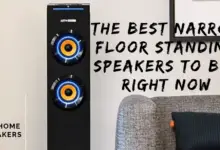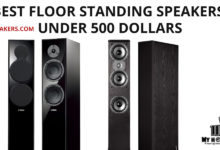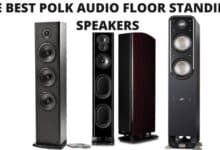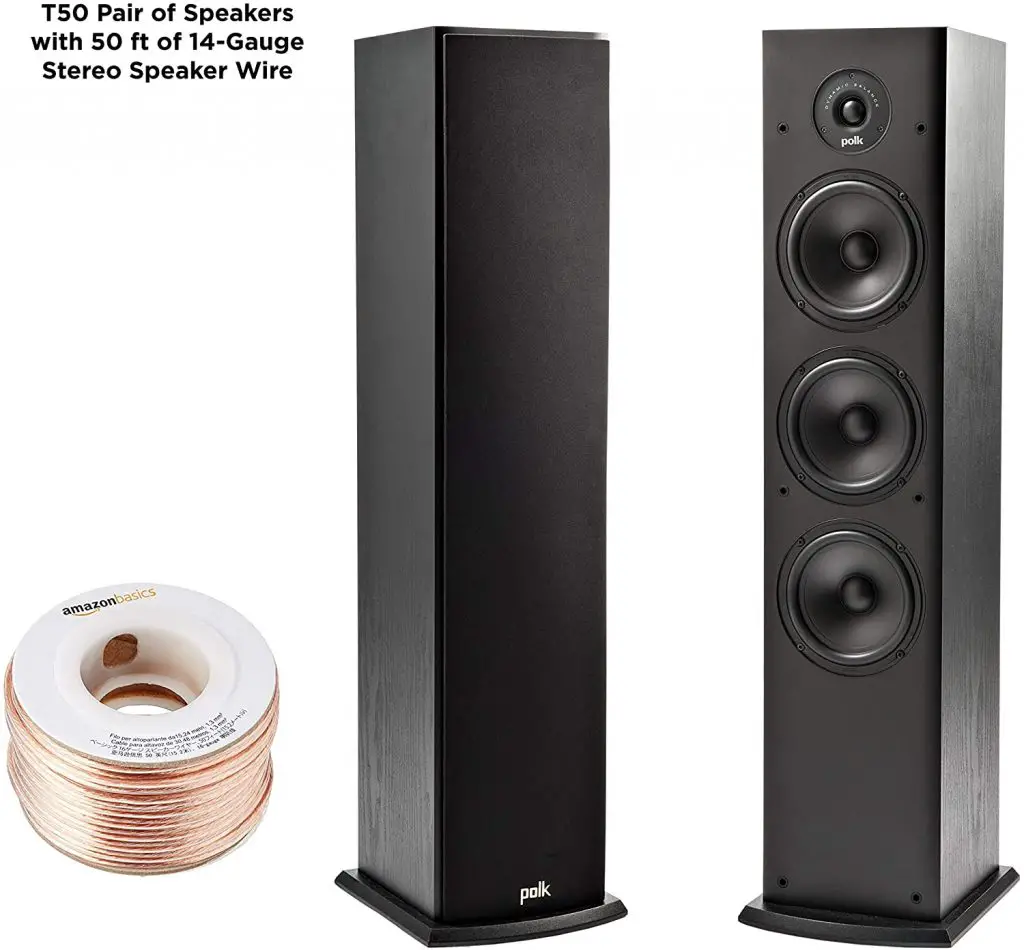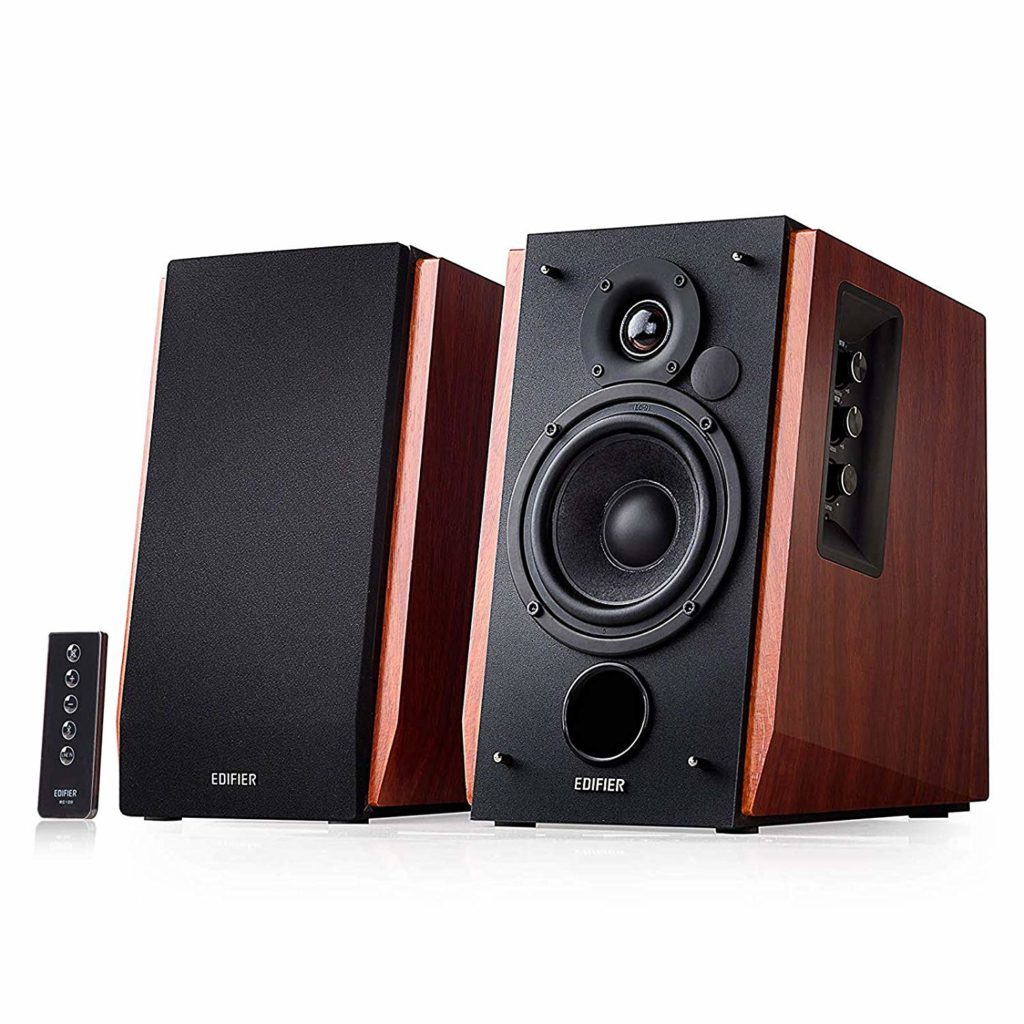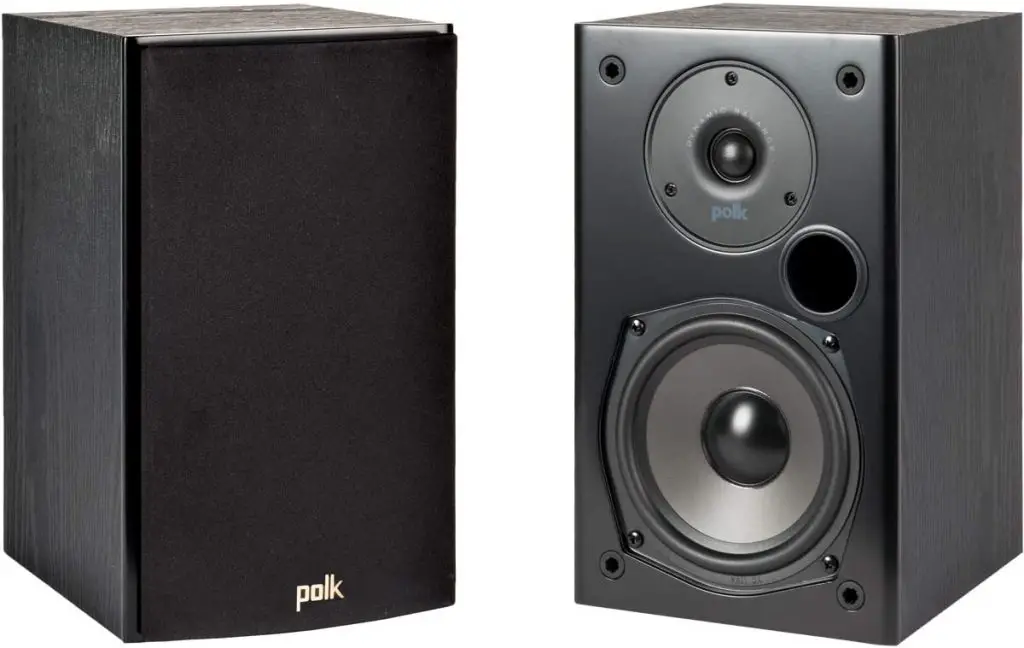Here in this article, we are going to compare Floor Standing vs. Bookshelf speakers – this article will touch quite a lot of aspects regarding these types of speakers, as well as list the top brands that produce each type.
There are typically two common types of speakers when classified by their physical aesthesis – bookshelf speakers and floor-standing speakers.
Some people also refer to floor-standing speakers as tower speakers – simply, whether it is called floor-standing speaker or tower speaker, the people calling either of these names are referring to a tall speaker that is usually not placed on any shelve or speaker stand; floor-standing speakers stand on their own and they’re typically slim.
Table of Contents
- 1 Floor standing vs. bookshelf speakers
- 2 Floor standing speakers
- 3 Advantages of floor-standing speakers
- 4 Disadvantages of floor-standing speakers
- 5 Bookshelf speakers
- 6 Advantages of bookshelf speakers
- 7 Disadvantages of bookshelf speakers
- 8 Comparing floor standing speakers and bookshelf speakers
- 8.1 Floor Standing vs. Bookshelf Speakers – design and build
- 8.2 Floor Standing vs. Bookshelf Speakers – stereo sound performance
- 8.3 Floor Standing vs. Bookshelf Speakers – add to an existing home theater system
- 8.4 Floor Standing vs. Bookshelf Speakers – coverage and range
- 8.5 Floor Standing vs. Bookshelf Speakers – performance
- 8.6 Floor Standing vs. Bookshelf Speakers – easy placements
- 9 Best floor standing speakers
- 10 Best bookshelf speakers
- 11 Summary
Floor standing vs. bookshelf speakers
When you buy a complete 7.1 home theater system, typically, you’ll get both floor standing speakers and bookshelf speakers along with a center channel speaker and subwoofer.
The inclusion of these two types of speakers helps to enhance the audio quality you will get, and re-create the cinema-level sound in your home.
Arguably, the combination of these two physical types of speaker delivers mind-blowing and punchy bass, even without a subwoofer.
However, these speakers have unique properties and features, which we are going to discuss in this article.
So the quick question is – do you want to buy a bookshelf speaker or a floor-standing speaker? You should understand how these speakers perform, as well as how best they should be placed in the room.
We are starting with floor-standing speakers.
Floor standing speakers
Also called tower speakers by many people, floor-standing speakers can stand on their own without any support – in the form of speaker stands or shelves.
Tower speakers are quite big and tall, but they’re typically not too wide like most bookshelf speakers.
However, Floor standing speakers are specially built to work alone without being clinched to a center speaker, amp, or audio receiver, and they deliver premium audio just like soundbars.
More so, this type of speaker comes with multi-driver – bass drivers, mid-range drivers, and tweeters.
This multi-driver design is the reason why tower speakers can be used as standalone speaker systems.
Interestingly, tower speakers provide complete stereo sound that can fill any room. They’re pretty versatile and easy to set up.
Advantages of floor-standing speakers
Standalone speaker system
Impressive bass output
Typically, floor-standing speakers tend to have better bass than bookshelf speakers, thanks to the multi-driver array.
Attractive designs
Also, tower speakers look more attractive than bookshelf speakers – they are tall, slim, and sleek. The aesthetics of floor-standing speakers seems better off than its counterpart.
Input/output ports
Since floor-standing speakers are designed to serve as standalone speakers, they typically feature multiple connectivity options; thus, you can connect your portable devices via USB or aux input.
Disadvantages of floor-standing speakers
They look bulkier
Obviously, floor-standing speakers look bulkier, and they’re heavier when moving about. Also, you may not find it easy to place tower speakers around the room because of their height.
Bookshelf speakers
Unlike tower speakers, bookshelf speakers are shorter, and they do not come with connectivity options.
However, there are some powered bookshelf speakers available in the market that comes with multiple connectivity options and do not require to be used with an amplifier or receiver.
Nevertheless, bookshelf speakers must be placed on a speaker stand, hanged on the wall, or placed on shelves.
They are not so tall and can be easily placed under the TV furniture steps.
Also, bookshelf speakers typically don’t come with bass drivers – most of them come with tweeters and some mid-bass drivers.
Thus, a bookshelf speaker cannot produce enough bass as a tower speaker would do. I guess you’re already taking some points out.
In some cases, bookshelf speakers are less expensive than floor-standing speakers.
Advantages of bookshelf speakers
1. Best for stereo setup
While tower speakers may be required in a stereo setup – bookshelf speakers are a must when setting up stereo sound for your home or studio.
This is because bookshelf speakers can be easily hanged anywhere in the room to sound from different corners.
2. No cabinet vibration
It is unlikely to notice the cabinet of a bookshelf speaker vibrating as a result of powerful/loud sound waves.
Cabinet vibration is quite common with floor-standing speakers, and most people don’t like it.
3. Portable and lighter in weight
Due to their small size – bookshelf speakers are lighter in weight than towers speakers and can be easily moved from one place to another. You can set them up in any space you wish.
4. Multiple installation options
You can mount bookshelf speakers on walls, place them on shelves, or speaker stands. These multiple placement options are not feasible for floor-standing speakers.
Disadvantages of bookshelf speakers
1. Low bass output
Actually, bookshelf speakers aren’t designed for bass – they do not feature bass drivers that are available on floor-standing speakers (tower speakers).
2. Usually not so loud as tower speakers
Though some bookshelf speakers are surprisingly very loud, many of them cannot reach the high level of volume you can get from floor-standing speakers.
Before we start comparing these two types of speakers by considering several factors – one common thing about the two is that they are sold in pairs.
You can either buy a pair of tower speakers or a pair of bookshelf speakers.
Comparing floor standing speakers and bookshelf speakers
Now let’s get into the main topic of the day – “Floor-Standing vs. Bookshelf Speakers.” What are the differences between these two speakers, and which one of them is best for your needs?
Hope you know that you can create a custom speaker following our comprehensive “how-to” guide? Here’s how to make a custom bookshelf speaker.
Floor Standing vs. Bookshelf Speakers – design and build
The truth here is that both tower speakers and bookshelf speakers are built with sturdy materials and drivers.
Different OEM’s design these speakers following different techniques – thus, it is difficult to arrive at a general conclusion on which type of speaker is best designed and studier; some bookshelf speakers are sturdier than floor-standing speakers – similarly, there are tower speakers that are sturdier and sleeker than bookshelf speaker. It all depends on the manufacturer and materials used.
Best – both
Floor Standing vs. Bookshelf Speakers – stereo sound performance
The reason why bookshelf speakers and tower speakers both come in pairs is to serve for Left and Right surrounds.
So, one of the pairs serves for the left surround while the other serves for the right surround; thus, whether you pick a pair of bookshelf speakers or floor-standing speakers, you can still enjoy stereo sound.
Moreover, it is important to note the bookshelf speakers are equipped with mid-range drivers and clean tweeters – plus, most bookshelf speakers deliver bi-directional sound. They are typically used to complement a surround sound system or setup.
On the other hand, floor-standing speakers come with all the drivers you will expect from the speaker.
This includes mid-range drivers, tweeters, and bass drivers. Also, tower speakers cover highs and lows in addition to mid-range; thus, you will get better stereo performance from floor-standing speakers than bookshelf speakers.
Best – floor-standing speakers
Floor Standing vs. Bookshelf Speakers – add to an existing home theater system
Both floor-standing speakers and bookshelf speakers can be integrated into an existing home theater system since they can be used as “Left” and “Right” channels for surround sound. But there are things you should understand.
If you’re using floor-standing speakers, you may need to get a subwoofer to complement the system, but that’s if the home theater system doesn’t come with a sub.
Also, if the tower speakers have built-in subwoofer drivers, there’s no need for an additional subwoofer.
On the other hand, if you choose to go with bookshelf speakers, then you must bring in a center channel speaker.
Best – both
Floor Standing vs. Bookshelf Speakers – coverage and range
Typically, floor-standing speakers are designed to be complete speaker systems; that’s why they are bigger in size and contain more components.
Tower speakers are meant to sound alone without being paired with other speakers – thus, they cover a wider range.
On the other hand, bookshelf speakers are designed to work with other speakers; thus, they are not packed with many drivers and do not cover a wider range as floor-standing speakers.
However, unless you’re picking a pair of audiophile bookshelf speakers, most bookshelf speakers don’t cover a wider range, but they sound pretty good.
Best – Floor-standing speakers
Floor Standing vs. Bookshelf Speakers – performance
Floor-standing speakers come with complete drivers – they seem to perform better from where they are placed.
However, you cannot place floor-standing speakers anywhere in the room, unlike bookshelf speakers.
Floor-standing speakers are usually placed around the corners from where they produce clean sound and mids.
Bookshelf speakers deliver cleaner sounds with fine-tuned tweeters. They sound pretty well, and their performance is quite plausible.
However, considering that bookshelf speakers can be easily placed around the room – either mounted on walls or placed on shelves – they tend to deliver better performance.
Best – Floor-standing speakers
Floor Standing vs. Bookshelf Speakers – easy placements
One of the factors that influence the type of speaker people buy for the home is placement options.
Bookshelf speakers can be placed virtually in any place because of their compact design and multiple placement options.
You can place bookshelf speakers on your work desk or install them on speaker shelves. However, not all bookshelf speakers would easily fit into a bookshelf – the actual fact here is that bookshelf speakers are smaller and portable.
Floor-standing speakers are tall (at least 3ft. tall), and they do not offer any placement option rather than being meant to stand on the floor.
You cannot hang tower speakers on the wall; neither is it possible to stand them on speaker stands.
Also, floor-standing speakers aren’t portable, and they are heavier than bookshelf speakers.
Best – Bookshelf speakers
There are more factors to consider when choosing a speaker for your need. Some features to look out for, including Dolby Atmos technology, input/connectivity options, built-in components, and more.
Nevertheless, you may consider buying a home theater system that comprises tower speakers and bookshelf speakers – yes, such a sound system may be costly, but it is worth the price.
Also, you may consider these floor-standing speakers or bookshelf speakers – they are the best in the market.
Best floor standing speakers
Polk T50 Floor Standing Tower Speaker (Pair)
The Polk T50 is a pair of floor-standing that performs very well for stereo sound. It is a pair of impressive tower speakers with up to 150W power.
These speakers support Dolby and DTS Surround sound technology. Plus, each of the pairs is equipped with a 1-inch tweeter driver, 6.5-inch driver, and dual 6.5-inch bass radiators.
You can use these speakers for many purposes, including playing back music, movies, gaming, etc.
Pioneer SP-FS52 Home Audio Floor Standing Loudspeaker
The design of this floor-standing speaker is quite unique – the cabinet design is distinctive and well-crafted for better performance.
Pioneer is a popular audio equipment manufacturer, and the brand has designed quite a lot of successful speakers. This tower speaker can be bought as a pair or individually.
Best bookshelf speakers
Edifier R1700BT Active Bluetooth Bookshelf Speakers
This pair of bookshelf speakers from Edifier delivers premium audio and supports multiple connectivity options.
It is a pair of powered speakers that feature dual aux inputs, a remote control, as well as supports Bluetooth connectivity.
The classic wood finish made the speakers look premium, and it would easily blend with any modern home décor.
Interestingly, Edifier offers 2-year warranty coverage for this pair of powered bookshelf speakers.
Polk Audio T15 Home Theater Bookshelf Speakers
These speakers from Polk Audio are flexible and can be mounted on the wall placed on a shelve.
The Polk Audio T50 is a pair of power bookshelf speakers packed with sturdy drivers for the best surround performance.
You can easily pair up these speakers with your existing home audio system to create a higher channel sound system. Remove the grille to discover the attractive, rugged design of PAT15.
Summary
This floor-standing vs. bookshelf speaker comparison is meant to guide anyone contemplating on which type of speaker is best for home audio needs.

